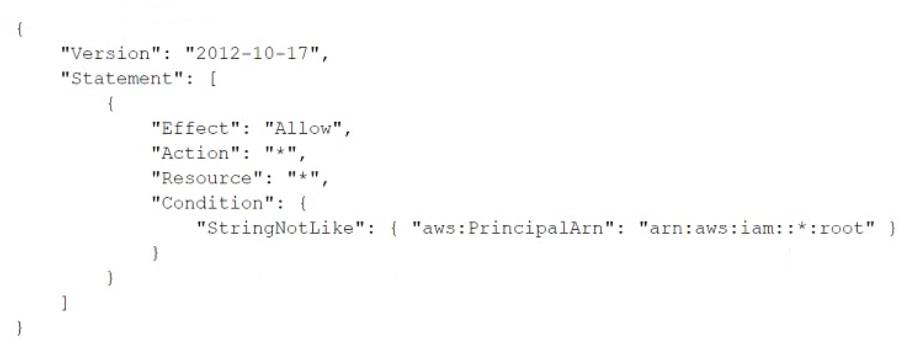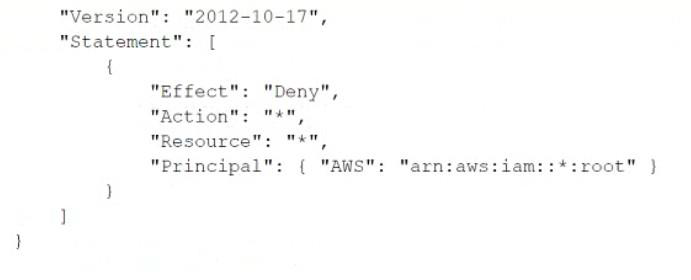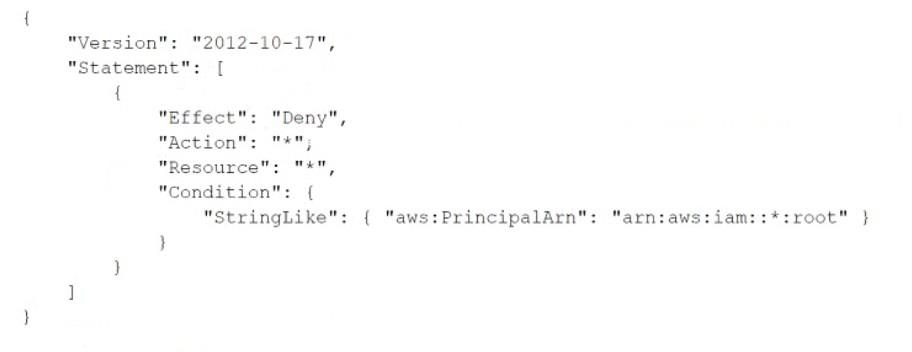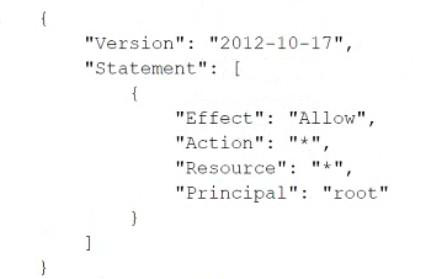Download AWS DevOps Engineer-Professional.DOC-C02.VCEplus.2024-08-25.65q.vcex
| Vendor: | Amazon |
| Exam Code: | DOC-C02 |
| Exam Name: | AWS DevOps Engineer-Professional |
| Date: | Aug 25, 2024 |
| File Size: | 644 KB |
| Downloads: | 6 |
How to open VCEX files?
Files with VCEX extension can be opened by ProfExam Simulator.
Discount: 20%
Demo Questions
Question 1
A company uses AWS Organizations to manage multiple accounts. Information security policies require that all unencrypted Amazon EBS volumes be marked as non-compliant. A DevOps engineer needs to automatically deploy the solution and ensure that this compliance check is always present.
Which solution will accomplish this?
- Create an AWS CloudFormation template that defines an AWS Inspector rule to check whether EBS encryption is enabled. Save the template to an Amazon S3 bucket that has been shared with all accountswithin the company. Update the account creation script pointing to the CloudFormation template in Amazon S3.
- Create an AWS Config organizational rule to check whether EBS encryption is enabled and deploy the rule using the AWS CLI. Create and apply an SCP to prohibit stopping and deleting AWS Config across theorganization.
- Create an SCP in Organizations. Set the policy to prevent the launch of Amazon EC2 instances without encryption on the EBS volumes using a conditional expression. Apply the SCP to all AWS accounts. UseAmazon Athena to analyze the AWS CloudTrail output, looking for events that deny an ec2:RunInstances action.
- Deploy an IAM role to all accounts from a single trusted account. Build a pipeline with AWS CodePipeline with a stage in AWS Lambda to assume the IAM role, and list all EBS volumes in the account. Publish areport to Amazon S3.
Correct answer: B
Explanation:
https://docs.aws.amazon.com/config/latest/developerguide/ec2-ebs-encryption-by-default.html https://docs.aws.amazon.com/config/latest/developerguide/ec2-ebs-encryption-by-default.html
Question 2
A company is performing vulnerability scanning for all Amazon EC2 instances across many accounts. The accounts are in an organization in AWS Organizations. Each account's VPCs are attached to a shared transit gateway. The VPCs send traffic to the internet through a central egress VPC. The company has enabled Amazon Inspector in a delegated administrator account and has enabled scanning for all member accounts.
A DevOps engineer discovers that some EC2 instances are listed in the 'not scanning' tab in Amazon Inspector.
Which combination of actions should the DevOps engineer take to resolve this issue? (Choose three.)
- Verify that AWS Systems Manager Agent is installed and is running on the EC2 instances that Amazon Inspector is not scanning.
- Associate the target EC2 instances with security groups that allow outbound communication on port 443 to the AWS Systems Manager service endpoint.
- Grant inspector:StartAssessmentRun permissions to the IAM role that the DevOps engineer is using.
- Configure EC2 Instance Connect for the EC2 instances that Amazon Inspector is not scanning.
- Associate the target EC2 instances with instance profiles that grant permissions to communicate with AWS Systems Manager.
- Create a managed-instance activation. Use the Activation Code and the Activation ID to register the EC2 instances.
Correct answer: ABE
Explanation:
https://docs.aws.amazon.com/inspector/latest/user/scanning-ec2.html https://docs.aws.amazon.com/inspector/latest/user/scanning-ec2.html
Question 3
A development team uses AWS CodeCommit for version control for applications. The development team uses AWS CodePipeline, AWS CodeBuild. and AWS CodeDeploy for CI/CD infrastructure. In CodeCommit, the development team recently merged pull requests that did not pass long-running tests in the code base. The development team needed to perform rollbacks to branches in the codebase, resulting in lost time and wasted effort.
A DevOps engineer must automate testing of pull requests in CodeCommit to ensure that reviewers more easily see the results of automated tests as part of the pull request review.
What should the DevOps engineer do to meet this requirement?
- Create an Amazon EventBridge rule that reacts to the pullRequestStatusChanged event. Create an AWS Lambda function that invokes a CodePipeline pipeline with a CodeBuild action that runs the tests for theapplication. Program the Lambda function to post the CodeBuild badge as a comment on the pull request so that developers will see the badge in their code review.
- Create an Amazon EventBridge rule that reacts to the pullRequestCreated event. Create an AWS Lambda function that invokes a CodePipeline pipeline with a CodeBuild action that runs the tests for theapplication. Program the Lambda function to post the CodeBuild test results as a comment on the pull request when the test results are complete.
- Create an Amazon EventBridge rule that reacts to pullRequestCreated and pullRequestSourceBranchUpdated events. Create an AWS Lambda function that invokes a CodePipeline pipeline with a CodeBuildaction that runs the tests for the application. Program the Lambda function to post the CodeBuild badge as a comment on the pull request so that developers will see the badge in their code review.
- Create an Amazon EventBridge rule that reacts to the pullRequestStatusChanged event. Create an AWS Lambda function that invokes a CodePipeline pipeline with a CodeBuild action that runs the tests for theapplication. Program the Lambda function to post the CodeBuild test results as a comment on the pull request when the test results are complete.
Correct answer: C
Explanation:
https://docs.aws.amazon.com/organizations/latest/userguide/orgs_manage_policies_scps.html?icmpid=docs_orgs_consoleSCPs (Service Control Policies) are the best way to restrict permissions at the organizational level, which in this case would be used to restrict modifications to the IAM role used by the auditing application, while still allowing trusted administrators to make changes to it. Options C and D are not as effective because IAM permission boundaries are applied to IAM entities (users, groups, and roles), not the account itself, and must be applied to all IAM entities in the account. https://docs.aws.amazon.com/organizations/latest/userguide/orgs_manage_policies_scps.html?icmpid=docs_orgs_console
SCPs (Service Control Policies) are the best way to restrict permissions at the organizational level, which in this case would be used to restrict modifications to the IAM role used by the auditing application, while still allowing trusted administrators to make changes to it. Options C and D are not as effective because IAM permission boundaries are applied to IAM entities (users, groups, and roles), not the account itself, and must be applied to all IAM entities in the account.
Question 4
A company has deployed an application in a production VPC in a single AWS account. The application is popular and is experiencing heavy usage. The company's security team wants to add additional security, such as AWS WAF, to the application deployment. However, the application's product manager is concerned about cost and does not want to approve the change unless the security team can prove that additional security is necessary.
The security team believes that some of the application's demand might come from users that have IP addresses that are on a deny list. The security team provides the deny list to a DevOps engineer. If any of the IP addresses on the deny list access the application, the security team wants to receive automated notification in near real time so that the security team can document that the application needs additional security. The DevOps engineer creates a VPC flow log for the production VPC.
Which set of additional steps should the DevOps engineer take to meet these requirements MOST cost-effectively?
- Create a log group in Amazon CloudWatch Logs. Configure the VPC flow log to capture accepted traffic and to send the data to the log group. Create an Amazon CloudWatch metric filter for IP addresses on thedeny list. Create a CloudWatch alarm with the metric filter as input. Set the period to 5 minutes and the datapoints to alarm to 1. Use an Amazon Simple Notification Service (Amazon SNS) topic to send alarm notices to the security team.
- Create an Amazon S3 bucket for log files. Configure the VPC flow log to capture all traffic and to send the data to the S3 bucket. Configure Amazon Athena to return all log files in the S3 bucket for IP addresseson the deny list. Configure Amazon QuickSight to accept data from Athena and to publish the data as a dashboard that the security team can access. Create a threshold alert of 1 for successful access. Configure the alert to automatically notify the security team as frequently as possible when the alert threshold is met.
- Create an Amazon S3 bucket for log files. Configure the VPC flow log to capture accepted traffic and to send the data to the S3 bucket. Configure an Amazon OpenSearch Service cluster and domain for the logfiles. Create an AWS Lambda function to retrieve the logs from the S3 bucket, format the logs, and load the logs into the OpenSearch Service cluster. Schedule the Lambda function to run every 5 minutes.Configure an alert and condition in OpenSearch Service to send alerts to the security team through an Amazon Simple Notification Service (Amazon SNS) topic when access from the IP addresses on the deny list is detected.
- Create a log group in Amazon CloudWatch Logs. Create an Amazon S3 bucket to hold query results. Configure the VPC flow log to capture all traffic and to send the data to the log group. Deploy an AmazonAthena CloudWatch connector in AWS Lambda. Connect the connector to the log group. Configure Athena to periodically query for all accepted traffic from the IP addresses on the deny list and to store the results in the S3 bucket. Configure an S3 event notification to automatically notify the security team through an Amazon Simple Notification Service (Amazon SNS) topic when new objects are added to the S3 bucket.
Correct answer: A
Question 5
A company has developed a serverless web application that is hosted on AWS. The application consists of Amazon S3. Amazon API Gateway, several AWS Lambda functions, and an Amazon RDS for MySQL database. The company is using AWS CodeCommit to store the source code. The source code is a combination of AWS Serverless Application Model (AWS SAM) templates and Python code.
A security audit and penetration test reveal that user names and passwords for authentication to the database are hardcoded within CodeCommit repositories. A DevOps engineer must implement a solution to automatically detect and prevent hardcoded secrets.
What is the MOST secure solution that meets these requirements?
- Enable Amazon CodeGuru Profiler. Decorate the handler function with @with_lambda_profiler(). Manually review the recommendation report. Write the secret to AWS Systems Manager Parameter Store as asecure string. Update the SAM templates and the Python code to pull the secret from Parameter Store.
- Associate the CodeCommit repository with Amazon CodeGuru Reviewer. Manually check the code review for any recommendations. Choose the option to protect the secret. Update the SAM templates and thePython code to pull the secret from AWS Secrets Manager.
- Enable Amazon CodeGuru Profiler. Decorate the handler function with @with_lambda_profiler(). Manually review the recommendation report. Choose the option to protect the secret. Update the SAMtemplates and the Python code to pull the secret from AWS Secrets Manager.
- Associate the CodeCommit repository with Amazon CodeGuru Reviewer. Manually check the code review for any recommendations. Write the secret to AWS Systems Manager Parameter Store as a string.Update the SAM templates and the Python code to pull the secret from Parameter Store.
Correct answer: B
Explanation:
https://docs.aws.amazon.com/codecommit/latest/userguide/how-to-amazon-codeguru-reviewer.html https://docs.aws.amazon.com/codecommit/latest/userguide/how-to-amazon-codeguru-reviewer.html
Question 6
A company uses AWS CloudFormation stacks to deploy updates to its application. The stacks consist of different resources. The resources include AWS Auto Scaling groups, Amazon EC2 instances, Application Load Balancers (ALBs), and other resources that are necessary to launch and maintain independent stacks. Changes to application resources outside of CloudFormation stack updates are not allowed.
The company recently attempted to update the application stack by using the AWS CLI. The stack failed to update and produced the following error message: 'ERROR: both the deployment and the CloudFormation stack rollback failed. The deployment failed because the following resource(s) failed to update: [AutoScalingGroup].'
The stack remains in a status of UPDATE_ROLLBACK_FAILED. *
Which solution will resolve this issue?
- Update the subnet mappings that are configured for the ALBs. Run the aws cloudformation update-stack-set AWS CLI command.
- Update the 1AM role by providing the necessary permissions to update the stack. Run the aws cloudformation continue-update-rollback AWS CLI command.
- Submit a request for a quota increase for the number of EC2 instances for the account. Run the aws cloudformation cancel-update-stack AWS CLI command.
- Delete the Auto Scaling group resource. Run the aws cloudformation rollback-stack AWS CLI command.
Correct answer: B
Explanation:
https://repost.aws/knowledge-center/cloudformation-update-rollback-failed If your stack is stuck in the UPDATE_ROLLBACK_FAILED state after a failed update, then the only actions that you can perform on the stack are the ContinueUpdateRollback or DeleteStack operations. https://repost.aws/knowledge-center/cloudformation-update-rollback-failed If your stack is stuck in the UPDATE_ROLLBACK_FAILED state after a failed update, then the only actions that you can perform on the stack are the ContinueUpdateRollback or DeleteStack operations.
Question 7
A company uses AWS Secrets Manager to store a set of sensitive API keys that an AWS Lambda function uses. When the Lambda function is invoked, the Lambda function retrieves the API keys and makes an API call to an external service. The Secrets Manager secret is encrypted with the default AWS Key Management Service (AWS KMS) key.
A DevOps engineer needs to update the infrastructure to ensure that only the Lambda function's execution role can access the values in Secrets Manager. The solution must apply the principle of least privilege.
Which combination of steps will meet these requirements? (Select TWO.)
- Update the default KMS key for Secrets Manager to allow only the Lambda function's execution role to decrypt.
- Create a KMS customer managed key that trusts Secrets Manager and allows the Lambda function's execution role to decrypt. Update Secrets Manager to use the new customer managed key.
- Create a KMS customer managed key that trusts Secrets Manager and allows the account's :root principal to decrypt. Update Secrets Manager to use the new customer managed key.
- Ensure that the Lambda function's execution role has the KMS permissions scoped on the resource level. Configure the permissions so that the KMS key can encrypt the Secrets Manager secret.
- Remove all KMS permissions from the Lambda function's execution role.
Correct answer: BD
Explanation:
The requirement is to update the infrastructure to ensure that only the Lambda function's execution role can access the values in Secrets Manager. The solution must apply the principle of least privilege, which means granting the minimum permissions necessary to perform a task. To do this, the DevOps engineer needs to use the following steps: Create a KMS customer managed key that trusts Secrets Manager and allows the Lambda function's execution role to decrypt. A customer managed key is a symmetric encryption key that is fully managed by the customer. The customer can define the key policy, which specifies who can use and manage the key. By creating a customer managed key, the DevOps engineer can restrict the decryption permission to only the Lambda function's execution role, and prevent other principals from accessing the secret values. The customer managed key also needs to trust Secrets Manager, which means allowing Secrets Manager to use the key to encrypt and decrypt secrets on behalf of the customer. Update Secrets Manager to use the new customer managed key. Secrets Manager allows customers to choose which KMS key to use for encrypting each secret. By default, Secrets Manager uses the default KMS key for Secrets Manager, which is a service-managed key that is shared by all customers in the same AWS Region. By updating Secrets Manager to use the new customer managed key, the DevOps engineer can ensure that only the Lambda function's execution role can decrypt the secret values using that key.Ensure that the Lambda function's execution role has the KMS permissions scoped on the resource level. The Lambda function's execution role is an IAM role that grants permissions to the Lambda function to access AWS services and resources. The role needs to have KMS permissions to use the customer managed key for decryption. However, to apply the principle of least privilege, the role should have the permissions scoped on the resource level, which means specifying the ARN of the customer managed key as a condition in the IAM policy statement. This way, the role can only use that specific key and not any other KMS keys in the account. The requirement is to update the infrastructure to ensure that only the Lambda function's execution role can access the values in Secrets Manager. The solution must apply the principle of least privilege, which means granting the minimum permissions necessary to perform a task. To do this, the DevOps engineer needs to use the following steps: Create a KMS customer managed key that trusts Secrets Manager and allows the Lambda function's execution role to decrypt. A customer managed key is a symmetric encryption key that is fully managed by the customer. The customer can define the key policy, which specifies who can use and manage the key. By creating a customer managed key, the DevOps engineer can restrict the decryption permission to only the Lambda function's execution role, and prevent other principals from accessing the secret values. The customer managed key also needs to trust Secrets Manager, which means allowing Secrets Manager to use the key to encrypt and decrypt secrets on behalf of the customer. Update Secrets Manager to use the new customer managed key. Secrets Manager allows customers to choose which KMS key to use for encrypting each secret. By default, Secrets Manager uses the default KMS key for Secrets Manager, which is a service-managed key that is shared by all customers in the same AWS Region. By updating Secrets Manager to use the new customer managed key, the DevOps engineer can ensure that only the Lambda function's execution role can decrypt the secret values using that key.
Ensure that the Lambda function's execution role has the KMS permissions scoped on the resource level. The Lambda function's execution role is an IAM role that grants permissions to the Lambda function to access AWS services and resources. The role needs to have KMS permissions to use the customer managed key for decryption. However, to apply the principle of least privilege, the role should have the permissions scoped on the resource level, which means specifying the ARN of the customer managed key as a condition in the IAM policy statement. This way, the role can only use that specific key and not any other KMS keys in the account.
Question 8
A company builds a container image in an AWS CodeBuild project by running Docker commands. After the container image is built, the CodeBuild project uploads the container image to an Amazon S3 bucket. The CodeBuild project has an 1AM service role that has permissions to access the S3 bucket.
A DevOps engineer needs to replace the S3 bucket with an Amazon Elastic Container Registry (Amazon ECR) repository to store the container images. The DevOps engineer creates an ECR private image repository in the same AWS Region of the CodeBuild project. The DevOps engineer adjusts the 1AM service role with the permissions that are necessary to work with the new ECR repository. The DevOps engineer also places new repository information into the docker build command and the docker push command that are used in the buildspec.yml file.
When the CodeBuild project runs a build job, the job fails when the job tries to access the ECR repository.
Which solution will resolve the issue of failed access to the ECR repository?
- Update the buildspec.yml file to log in to the ECR repository by using the aws ecr get-login-password AWS CLI command to obtain an authentication token. Update the docker login command to use theauthentication token to access the ECR repository.
- Add an environment variable of type SECRETS_MANAGER to the CodeBuild project. In the environment variable, include the ARN of the CodeBuild project's lAM service role. Update the buildspec.yml file to usethe new environment variable to log in with the docker login command to access the ECR repository.
- Update the ECR repository to be a public image repository. Add an ECR repository policy that allows the 1AM service role to have access.
- Update the buildspec.yml file to use the AWS CLI to assume the 1AM service role for ECR operations. Add an ECR repository policy that allows the 1AM service role to have access.
Correct answer: A
Explanation:
(A) When Docker communicates with an Amazon Elastic Container Registry (ECR) repository, it requires authentication. You can authenticate your Docker client to the Amazon ECR registry with the help of the AWS CLI (Command Line Interface). Specifically, you can use the 'aws ecr get-login-password' command to get an authorization token and then use Docker's 'docker login' command with that token to authenticate to the registry. You would need to perform these steps in your buildspec.yml file before attempting to push or pull images from/to the ECR repository. (A) When Docker communicates with an Amazon Elastic Container Registry (ECR) repository, it requires authentication. You can authenticate your Docker client to the Amazon ECR registry with the help of the AWS CLI (Command Line Interface). Specifically, you can use the 'aws ecr get-login-password' command to get an authorization token and then use Docker's 'docker login' command with that token to authenticate to the registry. You would need to perform these steps in your buildspec.yml file before attempting to push or pull images from/to the ECR repository.
Question 9
A company is hosting a static website from an Amazon S3 bucket. The website is available to customers at example.com. The company uses an Amazon Route 53 weighted routing policy with a TTL of 1 day. The company has decided to replace the existing static website with a dynamic web application. The dynamic web application uses an Application Load Balancer (ALB) in front of a fleet of Amazon EC2 instances.
On the day of production launch to customers, the company creates an additional Route 53 weighted DNS record entry that points to the ALB with a weight of 255 and a TTL of 1 hour. Two days later, a DevOps engineer notices that the previous static website is displayed sometimes when customers navigate to example.com.
How can the DevOps engineer ensure that the company serves only dynamic content for example.com?
- Delete all objects, including previous versions, from the S3 bucket that contains the static website content.
- Update the weighted DNS record entry that points to the S3 bucket. Apply a weight of 0. Specify the domain reset option to propagate changes immediately.
- Configure webpage redirect requests on the S3 bucket with a hostname that redirects to the ALB.
- Remove the weighted DNS record entry that points to the S3 bucket from the example.com hosted zone. Wait for DNS propagation to become complete.
Correct answer: D
Question 10
A company manages multiple AWS accounts in AWS Organizations. The company's security policy states that AWS account root user credentials for member accounts must not be used. The company monitors access to the root user credentials.
A recent alert shows that the root user in a member account launched an Amazon EC2 instance. A DevOps engineer must create an SCP at the organization's root level that will prevent the root user in member accounts from making any AWS service API calls.
Which SCP will meet these requirements?
Correct answer: D
HOW TO OPEN VCE FILES
Use VCE Exam Simulator to open VCE files

HOW TO OPEN VCEX AND EXAM FILES
Use ProfExam Simulator to open VCEX and EXAM files


ProfExam at a 20% markdown
You have the opportunity to purchase ProfExam at a 20% reduced price
Get Now!







